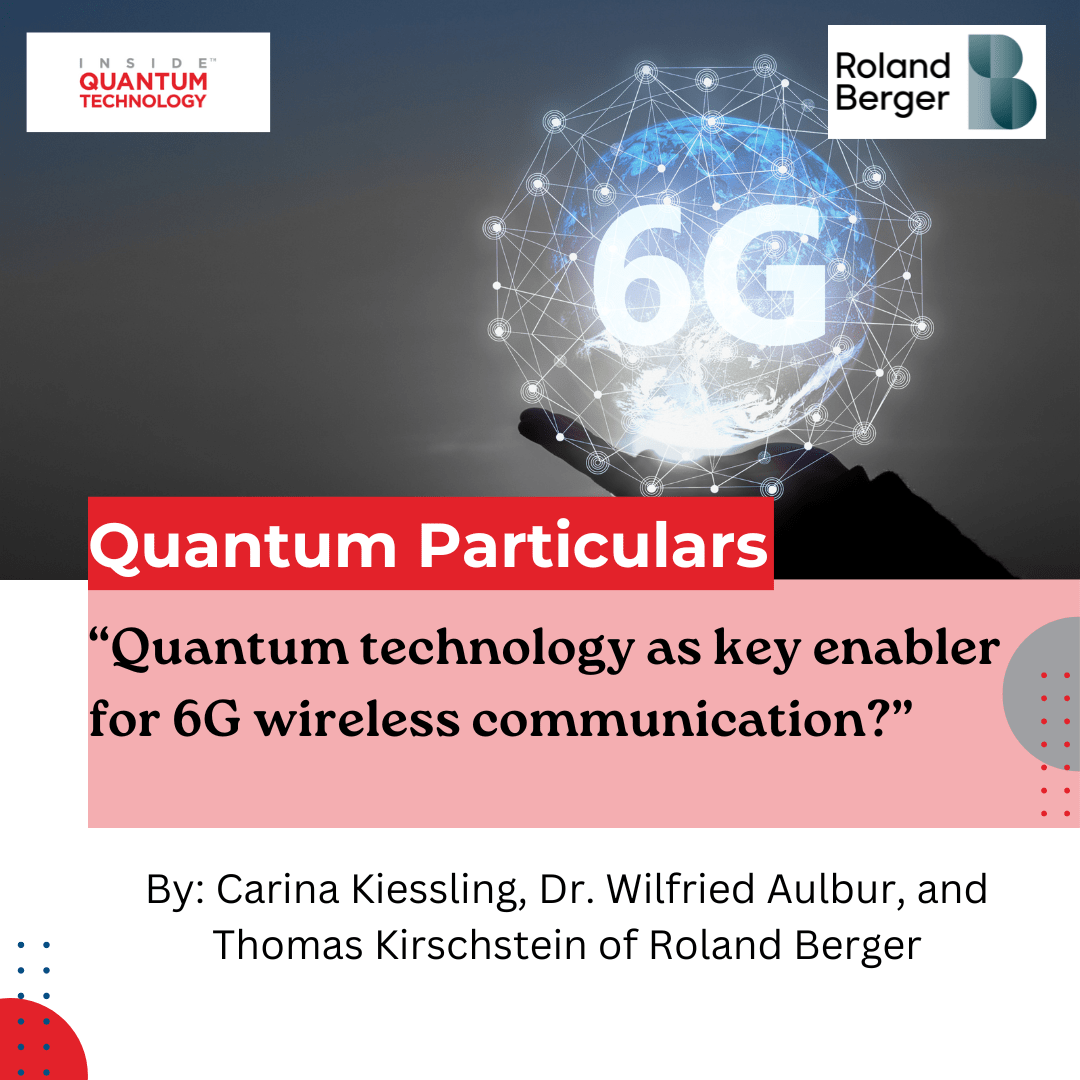Quantum Particulars Guest Column: “Quantum technology as key enabler for 6G wireless communication?”

“Quantum Particulars” is an editorial guest column featuring exclusive insights and interviews with quantum researchers, developers, and experts looking at key challenges and processes in this field. This article, focusing on 6G and telecommunications with quantum technology, was written by Carina Kiessling, Senior Project Manager of the “Quantum, Photonics & Optics” Cluster at Roland Berger; Dr. Wilfried Aulbur, Senior Partner at Roland Berger; and Thomas Kirschstein, Partner at Roland Berger.
Quantum ICT and 6G telecommunication networks
A new telecommunication standard is on the horizon. 6G is expected to replace the current 5G networking standard by the end of this decade. The 6G standard will boost communication specifications such as bandwidths to several hundred GHz, latency to sub-milliseconds, and peak throughputs to 1Tbps. Still, the exact technical specifications for 6G have yet to be defined. Leading consortia, such as SEMI, are working towards a consensus on a 6G standard. This consensus gets even more challenging as new powerful technologies emerge. Quantum technologies, for example, could induce unprecedented breakthroughs in communication technologies.
A brief introduction to quantum technology and applications
Quantum technology can typically be divided into technology segments, e.g., quantum computing, quantum sensing, and quantum communication, supported by enabling technologies.
In the Beyond-NISQ era, quantum computers are expected to profoundly transform industries by solving specific problems much faster than current supercomputers which would otherwise take an almost infinite time. However, significant technical challenges remain, such as the need for ultra-low temperatures, complex control units, and overcoming electrical noise to get sufficiently powerful quantum computers operational to tackle real-world problems.
Two other segments are quantum sensing and quantum communication. Quantum sensors, already market-ready and some commercially available for decades, use quantum phenomena to measure parameters such as frequencies, pressures, and time with unprecedented accuracy. To function as a quantum sensor, four requirements must be met: coherent manipulation, discrete energy levels, interaction, initialization, and readout.
Quantum communication is still in its infancy with emerging proof of concepts and the first commercial applications such as quantum-encrypted communication. Typically, photons are used for quantum communication which can travel along cables such as optical fibers or over-the-air. Hence, space-bound and earth-bound communication networks must be distinguished.
Once range coverage issues are resolved and commercialization is achieved, quantum communication could offer, e.g., tap-proof communication using light-encoded qubits or quantum key distribution (QKD).
To date, the range limits of Earth-bound communication networks have moved around several hundred kilometers. Trusted nodes to encode and decode to reach larger distances present critical security issues. For space-bound communication systems, the limit is not the distance to low earth orbit (LEO) but rather the missing number of LEO satellites. To ensure full coverage of communication to Earth, a much larger connected network of satellites is needed in LEO. This process of sending more communication satellites to LEO has already started.
Yet, it remains in progress and is constrained by the technical complexity of building the satellites and sending them securely to their network orbit and political challenges in space law.
6G will vastly enhance the telecom-related capabilities of existing 5G networks
6G will exceed the telecom-related specifications of 5G, enabling a plethora of new use cases. While improved data transmission in mobile communications and resulting higher connection density is obvious, new applications in healthcare and AI/ML, as well as imaging, can be envisaged.
However, there are significant technical challenges that need to be overcome before a 6G network can be operated. These include efficient hardware designed for 6G-operation, i.e., high-frequency receivers and transmitters, as well as power-efficient data processing equipment.
Quantum and 6G – Is Quantum technology not an enabler for 6G?
Use cases of available quantum technologies that are ready to be commercialized and can contribute to realizing a 6G network are limited. From an R&D perspective, quantum technologies could accelerate the development of THz emitting devices, ultra-precise localization techniques, and optimization of LEO satellite communication networks.
In addition, the use of quantum technologies in the deployment and operation of a 6G network, i.e., quantum cryptography and quantum-based optimization, must currently be seen as an add-on rather than a true enabler of 6G.
There is a mismatch between the timing of R&D-, testing-, and go-to-market activities of 6G and the technology readiness of quantum technologies. Leading players target trials for 6G network market readiness for 2029-2030, with R&D efforts already underway.
At the same time, most quantum technology segments are still in the research phase. Advanced market readiness for quantum computing and quantum communication networks are slowly emerging towards the end of the decade, too late to impact 6G network developments now.
Innovations in material science, such as new high-mobility semiconductor materials for frequencies beyond 100GHz and new types of photoconductive semiconductors for high-power THz signal generation, will progress 6G networks but are not ready yet for currently ongoing R&D.
Quantum technologies today are not mature enough to support the 6G deployment by the decade’s end. Hence, an independent consideration of both timelines is required. Nonetheless, add-on quantum technologies might bring significant advantages in the operation and use of 6G networks at a later stage. For high-tech companies in the semiconductor, TMT, and quantum technology, as well as public authorities, the preparation to integrate quantum technologies and 6G networks starts earlier than for end-users.
To participate in the boost that quantum technology add-ons will bring towards the end of the decade, it is now time to define a strategy for getting involved. This could be, for example, through investments in start-ups, research, building local technology hubs, understanding or defining prerequisite future regulatory requirements, or entering strategic partnerships, even beyond the industry.
Roland Berger has highly experienced experts in advanced technologies such as quantum, photonics & optics, semiconductors, electrics & electronics, battery chemistry, and more. We are prepared to support your needs with our extensive industry knowledge and a history of client success. Please feel free to contact the members of our RB Advanced Technology team.
Carina Kiessling is a Senior Project Manager of the “Quantum, Photonics & Optics” Cluster at Roland Berger; Dr. Wilfried Aulbur is a Senior Partner at Roland Berger; and Thomas Kirschstein is a Partner at Roland Berger.























